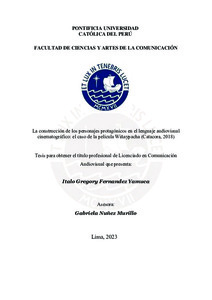| dc.contributor.advisor | Nuñez Murillo, Gabriela | |
| dc.contributor.author | Fernandez Yamuca, Italo Gregory | |
| dc.date.accessioned | 2023-10-27T15:08:16Z | |
| dc.date.available | 2023-10-27T15:08:16Z | |
| dc.date.created | 2023 | |
| dc.date.issued | 2023-10-27 | |
| dc.identifier.uri | http://hdl.handle.net/20.500.12404/26255 | |
| dc.description.abstract | El presente trabajo tuvo como objetivo descubrir cómo el lenguaje audiovisual contribuye a la
construcción de Willka y Phaxsi, personajes principales de la película Wiñaypacha. Se trató
de una investigación de enfoque cualitativo con un alcance exploratorio-descriptivo.
Asimismo, se emplearon matrices de análisis de contenido y se realizaron entrevistas a tres
especialistas que tienen conocimiento del lenguaje audiovisual y del contenido de la película.
Por otro lado, las hipótesis de la investigación estuvieron relacionadas con qué elementos del
lenguaje audiovisual permiten la construcción de los personajes: encuadres, luz, utilería,
decorado, voces, efectos sonoros, emoción, etc. Por último, los resultados del estudio
confirmaron que las distintas áreas del lenguaje audiovisual contribuyen a que los personajes
se integren como una gran unidad cohesionada de forma armoniosa en el largometraje. | es_ES |
| dc.description.abstract | The aim of this study was to discover how audiovisual language contributes to the
construction of Willka and Phaxsi, the main characters in the film Wiñaypacha. It was a
qualitative research with an exploratory-descriptive scope. Likewise, content analysis
matrices were used and interviews were conducted with three specialists who have
knowledge of the audiovisual language and the content of the film. On the other hand, the
research hypotheses are related to which elements of the audiovisual language allow the
construction of the characters: framing, light, props, set design, voices, sound effects,
emotion, etc. Finally, the results of the study prove that the different areas of audiovisual
language contribute to the integration of the characters as a large, harmoniously cohesive unit
in the feature film. | es_ES |
| dc.language.iso | spa | es_ES |
| dc.publisher | Pontificia Universidad Católica del Perú | es_ES |
| dc.rights | info:eu-repo/semantics/openAccess | es_ES |
| dc.rights.uri | http://creativecommons.org/licenses/by/2.5/pe/ | * |
| dc.subject | Lenguaje audiovisual | es_ES |
| dc.subject | Cine peruano--Siglo XXI | es_ES |
| dc.subject | Productores y directores de cine--Perú | es_ES |
| dc.subject | Catacora, Óscar | es_ES |
| dc.title | La construcción de los personajes protagónicos en el lenguaje audiovisual cinematográfico: el caso de la película Wiñaypacha (Catacora, 2018) | es_ES |
| dc.type | info:eu-repo/semantics/bachelorThesis | es_ES |
| thesis.degree.name | Licenciado en Comunicación Audiovisual | es_ES |
| thesis.degree.level | Título Profesional | es_ES |
| thesis.degree.grantor | Pontificia Universidad Católica del Perú. Facultad de Ciencias y Artes de la Comunicación. | es_ES |
| thesis.degree.discipline | Comunicación Audiovisual | es_ES |
| renati.advisor.dni | 25742350 | |
| renati.advisor.orcid | https://orcid.org/0000-0001-9033-2268 | es_ES |
| renati.author.dni | 77435326 | |
| renati.discipline | 211086 | es_ES |
| renati.juror | Rubina Vargas, Celia Isabel | es_ES |
| renati.juror | Nuñez Murillo, Gabriela | es_ES |
| renati.juror | Valdivieso Ariansen, Aurora | es_ES |
| renati.level | https://purl.org/pe-repo/renati/level#tituloProfesional | es_ES |
| renati.type | https://purl.org/pe-repo/renati/type#tesis | es_ES |
| dc.publisher.country | PE | es_ES |
| dc.subject.ocde | https://purl.org/pe-repo/ocde/ford#5.08.00 | es_ES |







